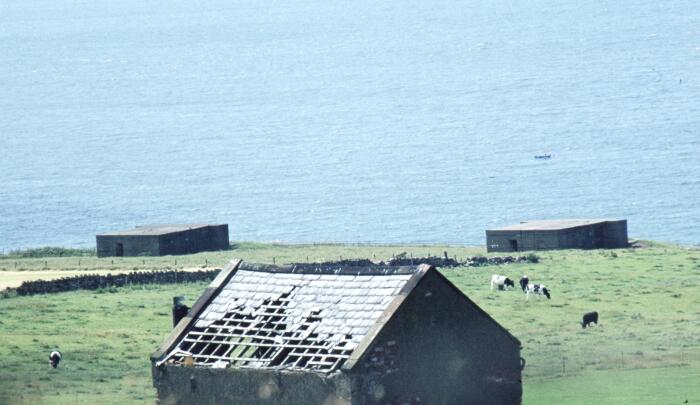
The two gun casements on the cliffs were demolished in the 1980's, and the searchlight emplacements have all but disappeared, with just the bases remaining. Local man Frank Lewthwaite was a young Army Cadet in 1943, and produced this magnificent sketch of the Bransty gun battery as viewed from the road above.
Frank kindly provided me with background information on the guns, excerpts from 561 Regiment war-diaries, and photographs of the searchlight emplacements prior to ruination by the council in June, 1995. I also wish to extend my gratitude to the late Harold Clifford, who - as Gunner Clifford of the 561st Coast Regiment, R. A. - operated the battery searchlights during the early years of WWII, and was able to provide much of the information laid down on this page
A similar coastal-defence arrangement existed eight miles up the coast at Workington on Oldside shore, and it was here, twenty-odd years after the end of WWII, that my interest in defence infrastructure began, when my Father and I explored the remnants of our coastal defence system. Oldside shore has since been subject to "redevelopment" and - sadly - all vestiges of our wartime heritage there have vanished; not a trace remains....
BELOW:
The gun casements as seen from the Bransty road. As observed in the sketch, the battery encampment extended some distance behind them, up the fields. I have produced a graphical illustration - based on a 1948 aerial photograph and a 1971 OS map - showing the relative layout of the battery, with the exception of the minature range.

The pictures immediately below are of one of the the Bransty guns during WWII. (The smaller pictures are links to larger versions!) This was a French 138mm M10 gun from the cruiser "Paris." The other gun was identical. Unfortunately, due to the (relatively) unusual calibre of the guns (about 5.43 inches in imperial measurement), ammunition was scarce, and could not be wasted on shooting practice! These guns replaced the original 4" BL MkVII french naval guns, which were sent to the Port Talbot battery on 1st December 1941 - later to be sent on to the Mumbles. Whitehaven battery ceased operation on the 1st June 1945.
GUN PHOTOS BELOW: Jeff Wilson. and Frank Lewthwaite
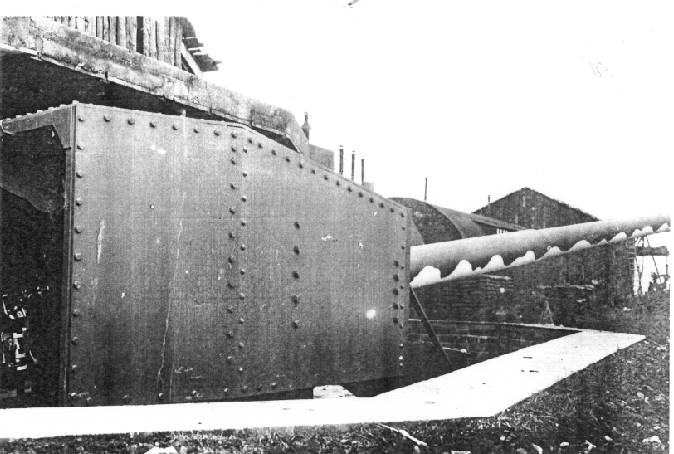
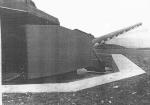 The
The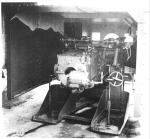 battery on the clifftop level was protected by Lewis guns at either end, with anti-aircraft protection offered by the then secret ZAA-Batteries, otherwise known as 'UP's' - Unrotated Projectiles: Devices by which means a cluster of sixteen explosive-carrying rockets would be released electrically to bring down any attacking aircraft by exploding at a pre-determined altitude. Also used to protect the Workington coast-battery.
battery on the clifftop level was protected by Lewis guns at either end, with anti-aircraft protection offered by the then secret ZAA-Batteries, otherwise known as 'UP's' - Unrotated Projectiles: Devices by which means a cluster of sixteen explosive-carrying rockets would be released electrically to bring down any attacking aircraft by exploding at a pre-determined altitude. Also used to protect the Workington coast-battery.
As well as guns, Battery Observation Post (BOP) and camp up on the cliff-tops, the Whitehaven battery consisted of two concrete and steel searchlight emplacements and a generator building, tucked in to the foot of the sandstone cliffs about 100 feet below, just above the Barrow to Carlisle railway line and on the site of some 19th Century Ironworks. A minature range was provided for training purposes, and was located about half-way between the searchlight emplacements and Parton, just off the 'Waggon Road'.
The north searchlight - No: 1 - was manually operated by the 12 to 18-strong searchlight crew, while positioning of the No: 2 southernmost searchlight was automatically controlled from the BOP on the cliffs above, presumably by a 'SELSYN' or 'MAGSLIP' arrangement (electrical transmission of angular torque between machines).
Communication from the BOP to the searchlights below was by field-telephone, and the aerial-type device next to the south Lewis-Gun (see sketch) was used to carry the telephone wire safely over the cliff edge and down to the searchlight positions. A wire barrage-balloon cable was also rigged to allow the transportation of sea-coals up to the cookhouse stove, to augment the regular fuel supply!
The remains of the searchlight emplacements are all that is now left of this site, and are shown in the photos below. Fortunately, Frank Lewthwaite managed to get some pictures of the remains before demolition (lower row of photographs). Both searchlights were 90 centimetre Mk V converted 'ack-ack' (Anti-Aircraft) arc lamps running on Direct-Current, providing fifty minutes of intense white light before the carbons needed replacing. The top carbon was connected to the positive end of the supply, and burned away more quickly than the bottom (negative) rod as minute particles of carbon were torn from the positive rod leaving a crater, on to the tip of the negative rod, forming a point
The channels cut into the concrete floor were for the searchlight power-supply cables, and the routes they take betray the positions of the controls and switch-gear within the searchlight enclosures. The routing of these channels is different for each searchlight, the southern one being the remote-controlled unit. 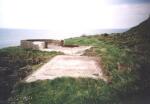 The LH picture of the south searchlight base shows an adjoining concrete plinth. This was the site of a brick-built loop-holed look-out post, and was used as a 'watch-shelter'
The LH picture of the south searchlight base shows an adjoining concrete plinth. This was the site of a brick-built loop-holed look-out post, and was used as a 'watch-shelter' 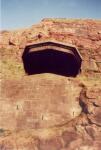 by the searchlight crew, as there was no room for observation duties in the light emplacements themselves.
by the searchlight crew, as there was no room for observation duties in the light emplacements themselves.
Of the generator plant, the engine-mounting plinths can clearly be seen, where the two main 'Lister' engines and generator sets were anchored down with sections of railway line. A 'Crosby' engine was provided as a stand-by if either of the main engines failed. These engines would be manually cranked over by two men using a gigantic starting handle, the success of which depended on the position of a control-rod, which - if it happened to have fallen half-way out - would require another go! A knife-switch attached to each of the searchlights would then be thrown in, closing the circuit and striking the powerful arc.
Construction of the searchlight generator plant was from the curved concrete sections so beloved of Ministry of Fortifications and Works architects. Fuel for the engines was bunkered in a tank next to the generator shelter, and was replenished by deliveries from Workington on a 13 cwt. flat-bed lorry up a slip-way off the 'Waggon Road'. The lower left-hand picture in the group of six above is of the south searchlight position (minus roof) from the top of the generator plant.
Pictured right is another view of the north searchlight - this time from below, looking up at the cliffs upon which the guns stood. Note the 'American Cop's hat' roof and the upper steel shutter runner. The searchlight shutters could be drawn across the lamp, cutting out extraneous light as well as protecting from the elements.
Home | Contents | Workington | Links | E-Mail